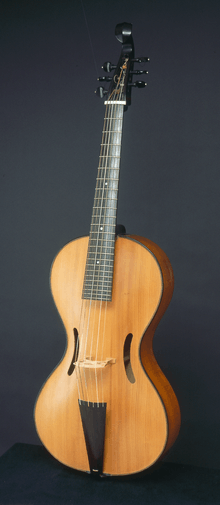Arpeggione
| Classification | Bowed string instrument |
|---|---|
| Related instruments | |
|
Cello Guitar Viol Vihuela | |

The arpeggione is a six-stringed musical instrument, fretted and tuned like a guitar, but bowed like a cello, and thus similar to the bass viola da gamba. So it had another name called guitar violoncello.[1] The body shape of the instrument is, however, more similar to a medieval fiddle than either the guitar or the bass viol. The instrument was essentially a bass viol with a guitar-type tuning,E–A–d–g–b–e' . The arpeggione was especially suited to playing runs in 3rds, double stops and arpeggios.[1]
It enjoyed a brief vogue, perhaps a decade, after its invention around 1823, by the Viennese instrument luthiers Johann Georg Stauffer and Peter Teufelsdorfer. The only notable piece extant for the instrument is a sonata with piano accompaniment by Franz Schubert, D.821, not published until 1871, when the arpeggione was long out of popularity. This sonata is now commonly played on the cello or viola, and many other instruments have received transcriptions as well.
References
- 1 2 "arpeggione". oxford music online. Retrieved 15 September 2016.
- Aquino, F. Avellar de. "Six-Stringed Virtuoso". The Strad Magazine, Harrow, Middlesex, UK, v. 109, n. 1297, p. 500–507, May 1998. About the arpeggione and Schubert's Sonata.
- Geiringer, Karl. "Schubert's Arpeggione Sonata and the "Super Arpeggione." "Musical Quarterly", 65, no. 4 (Oct. 1979), pp. 513-523.
- Sadie, Stanley, ed., The New Grove Dictionary of Music and Musicians, vol. 16, 6th. ed., London: Macmillan Press Limited, 1980. s.v. "Schubert, Franz" by Maurice J. E. Brown.
- Staufer, Vincenz. "Anleitung zur Erlernung des . . . neu erfundenen Guitarre-Violoncells. Vienna: Diabelli.
- Tree, Michael, "Schubert’s Arpeggione Sonata". The Strad Magazine, vol. 105, February 1994, p. 142. Master-Class on Schubert's Sonata.
External links
- Nicolas Deletaille's webpage on the arpeggione, a lot of useful information on the arpeggione. (The last fairly trouble-free archive version of this page is at Archive of Nicolas Deletaille's webpage on the arpeggione.)
- Homepage of the "Arpeggione World". Osamu Okumura, Japanese has restored OK-model and Anton Mitteisーmodel of Arpeggione making by himself.
- Photo